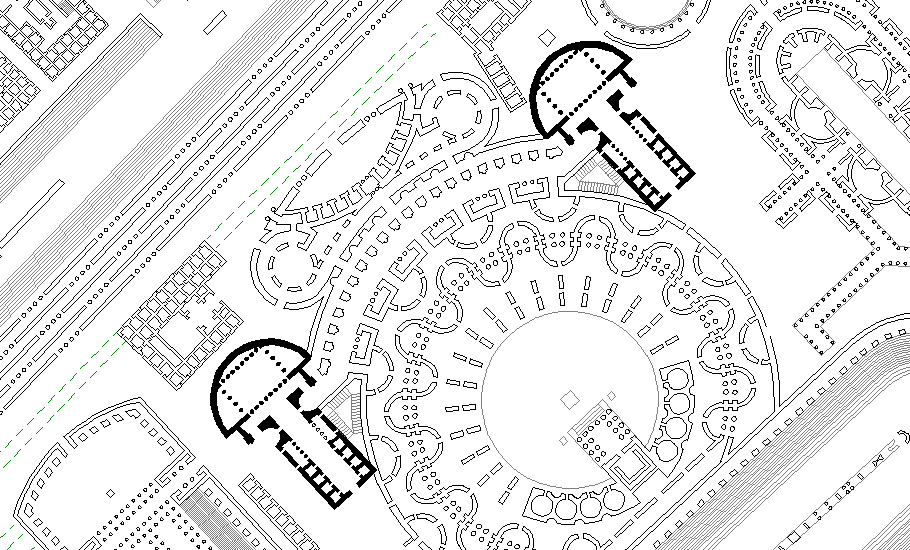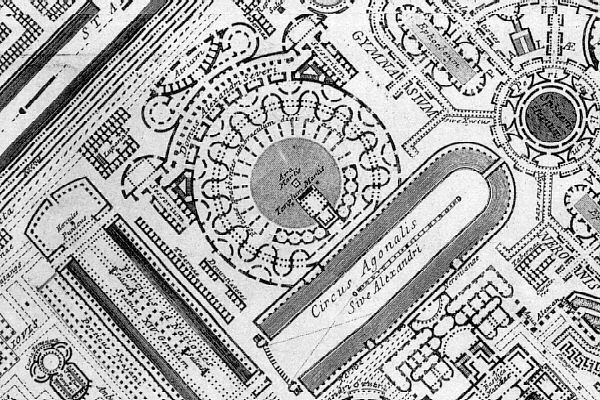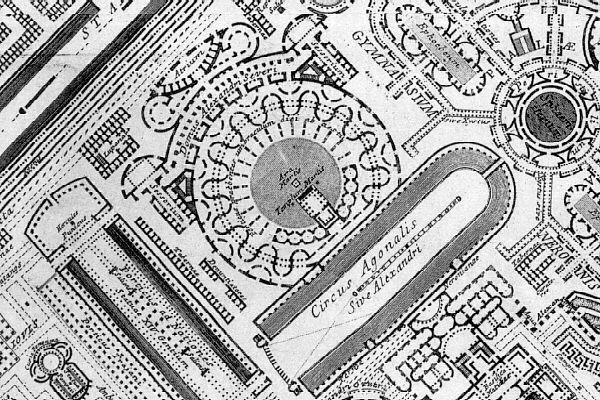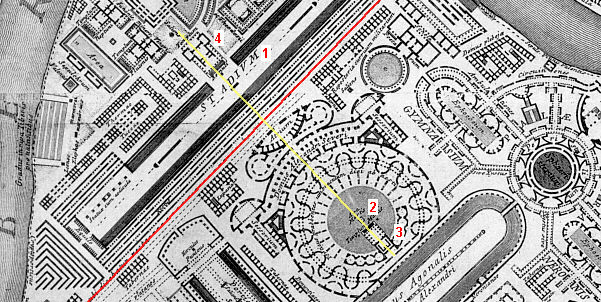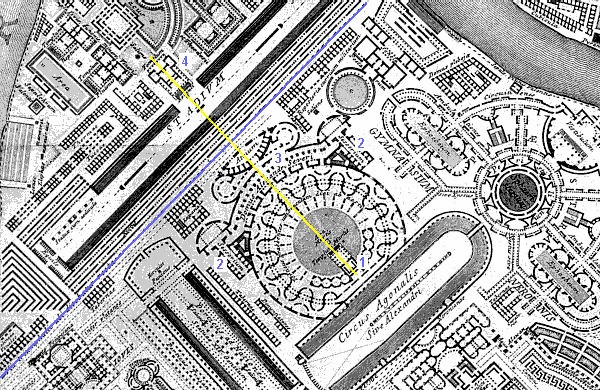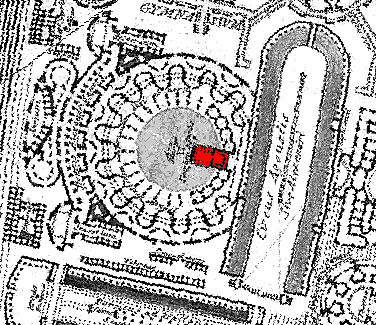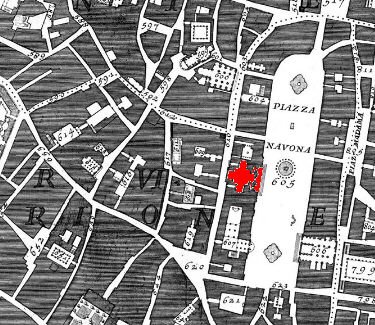new palace of Elagabalus
1998.09.21
from: Amanda Claridge, Rome: An Oxford Archeological Guide (Oxford: Oxford University Press, 1998).
p. 21:
Bassianus, came to Rome in 219 and, holding the family priesthood of the sun-god Elalgabalus, declared that he and the god were one and the same, building himself a temple on the Palatine and laying out a new palace, later called the 'Sessorian', with its own circus and amphitheater, on older imperial property in the south-east sector of the city (S. Croce in Gerusalemme).
This description fits perfectly Piranesi's design of the Domus Alexandri Severi. Piranesi's reason for doing this is unclear however... ...can only speculate there is some kind of inversion message involved.
21 April 1999 (Rome's birthday)
1999.04.21
The path that ultimately lead me to Helena began with my learning about a deliberate connection between Piranesi's Ichnographia Campus Martius and Saint Agnes of Rome. According to ancient tradition, the first "structure" within the Campus Martius was an altar erected by Romulus in honor of his father Mars. Piranesi situates the Ara Martis within the generally accepted location of the original altar, that is, within the area between the present day Piazza Navona and the Tiber to the west. In Piranesi's plan, the altar of Mars is within a circular pool in front of a Temple of Mars and is furthermore surrounded by an extensively curvilinear porticus. Additionally, the Domus Alexandri Severus (1) flanked by two Sessorium (2) is to the west.
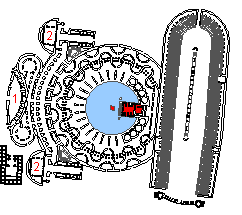 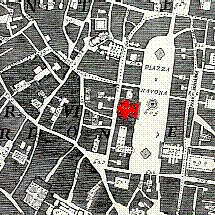
Investigating the meaning of Piranesi's Ara Martis layout, I looked to Nolli's 1748 Plan of Rome for a possible connection. I chose this approach because I had already learned that Piranesi indeed sometimes cleverly disguised links between his Ichnographia and Nolli's plan. The only potential tie between the two maps at the Ara Martis juncture is the coinciding position of the Templum Martis and the baroque church of St. Agnes on the Piazza Navona. At this point it became necessary for me to investigate the story of Saint Agnes.
Saint Agnes died in Rome circa 249 as a thirteen year old virgin and martyr. "Her riches and beauty excited the young noblemen of the first families of Rome to contend as rivals for her hand. Agnes answered them all that she had consecrated her virginity to a heavenly husband, who could not be beheld by mortal eyes. Her suitors, finding her resolution unshakable, accused her to the governor as a Christian, not doubting that threats and torments would prove more effective with one of her tender years on whom allurements could make no impression."1 As a form of torture, Agnes was sent to a brothel where her vow of virginity would be threatened and almost certainly eradicated. According to the legend, however, an angel protected Agnes while she was in the brothel, and subsequently Agnes was put to death. The traditional location of the brothel of Agnes' torture is the site of St. Agnes on the Piazza Navona. Moreover, the subsequent execution of Agnes sent shockwaves throughout both pagan and Christian Rome because the worst possible thing any Roman could do was to kill a virgin. Suddenly, and ironically, the Roman persecution of Christians took on the guise of a pagan moral dilemma.
The martyrdom of Agnes signifies a pivotal point of pagan-Christian inversion, and this inversion is precisely what Piranesi delineates within the complex of the Ara Martis. First, the co-positioning of the Templum Martis and the church of St. Agnes represents the origin of Rome itself when Mars raped the Vestal Virgin Rhea, who subsequently became mother to Romulus and Remus. Second, the emperor Alexander Severus is known for having been very interested and sympathetic towards Christianity, to the point where he seriously considered proclaiming Jesus as one of the official Roman gods as well as carving the (inverting) words "do unto others as you would have them do unto you" over the door of his house. Third, Sessorium is a direct reference to the Palatium Sessorianum, the imperial estate that became Helena's residence in Rome after 312, and soon thereafter the church of Santa Croce in Gerusalemme. It seems quite evident that Piranesi was well aware of early Christian history, including its architectural history.
Personally, I wonder whether Piranesi recognized Helena as an architect as well.
1 Herbert Thurston, S.J. and Donald Attwater, editors, "St Agnes" in Butler's Lives of the Saints (New York: P.J. Kenedy & Sons, 1956), v. 1, pp. 133-4.
Pagan - Christian - Triumphal Way
3123h
3123i
3123j
3123k
1999.11.21
...first encountered the word/name Sessorium
2002.06.12
It was within Piranesi's Ichnographia Campus Martius that I first encountered the word/name Sessorium. There are two identical building plans labeled Sessorium symmetrically positioned at either extreme of the Domus Alexandri Severi, which forms half of the complex surrounding the Ara Martis, the original Altar to Mars as erected by Romulus, adjacent to the Circus Agonalis Sive Alexandri, today's Piazza Navona, Rome.
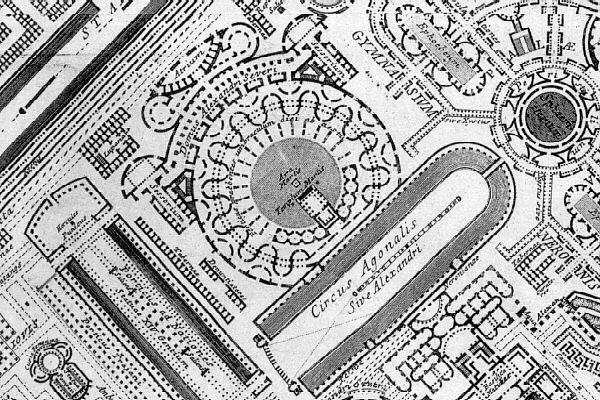
Detail of the Ichnographia Campi Martii with the Domus Alexandri Serveri toward the upper left center and the two Sessorium either side of the Domus Alexandri Severi.
The Latin definition of sessorium is first stool or chair, and, secondly, a place of residence, a dwelling, or habitation. It is, of course, the latter definitions that best fit the Sessorium as delineated within the Ichnographia Campus Martius, and there was, for the time being, no reason to think that there might be some further significance to the delineation and position of these plans within the larger, overall plan of the Campo Marzio.
| |
...there indeed once was a Sessorian Palace...
2002.06.12
In September 1998, I found out that there indeed once was a Sessorian Palace at Rome, but it was not located within the Campus Martius, nor was the Sessorian Palace a residence of the emperor Alexander Severus.
"Bassianus, came to Rome in 219 and, holding the family priesthood of the sun-god Elagabalus, declared that he and the god were one and the same, building himself a temple on the Palatine and laying out a new palace, later called the 'Sessorian', with its own circus and amphitheatre, on older imperial property in the south-east sector of the city."
Amanda Claridge, Rome: An Oxford Archeological Guide (Oxford: Oxford University Press, 1998), p. 21.
Elagabalus, a young teenage emperor reigning from 218-222 A.D., was succeeded by his cousin, Alexander Severus, who reigned 222-235 A.D. It is interesting to note that the description of the real Sessorian Palace somewhat matches the Domus Alexandri Severi as delineated by Piranesi, specifically how both palaces incorporate a circus/amphitheater.
Elagabalus was a homosexual, and, although he married several times, once even to a Vestal Virgin, he never produced an heir.
"The emperor also became involved in a series of homosexual crushes, most notably with the charioteer Hierocles. These favorites were given authority in the government, offending aristocrats, bureaucrats and troops alike. Elagabalus' personal style seemed effeminate and inappropriate to his office. Tales circulated that he spent his evenings pretending to be a female prostitute and that he wanted to have a vagina surgically implanted into his body."
www.roman-emperors.org/elagabal.htm
Could it be that Elagabalus located his new palace in Rome's south-east corner because it was close to the Castra Equitum Singuarlium, the barracks of the equites singulares, a select corps of cavalry organized about the end of the first century as a bodyguard for the emperor?
"The Sessorium, a building known in later times as the palatium Sessorianum, was standing in the first century, when it is mentioned as being near the spot where the execution of criminals took place. The origin of the name is unexplained, but the building became an imperial residence in the fourth century and was a favorite home of Helena, the mother Constantine. Its site is known, for the Church of S. Croce in Gerusalemme occupies one of the halls of the ancient palace."
Samuel Ball Platner, The Topography and Monuments of Ancient Rome (Boston: Allyn and Bacon, 1904), p. 448.
Given Elagabalus' reputation, it is perhaps understandable why Platner does not mention Elagabalus as the Sessorian Palace's builder and first imperial resident. Helena moved into the Sessorian Palace almost 100 years after Elagabalus' reign, and her reason for choosing the Sessorian Palace most likely coincides with Constantine's dissolution of the equites singulares, and his subsequently giving the land of the Castra Equitum Singularium and the adjacent Lateran Palace to the Papacy. Essentially, Helena moved in next door to the Pope.
So, with all the background of the Sessorian Palace, why did Piranesi fuse the Domus Alexandri Serveri and the Sessorium and place them in a completely other part of Rome within the Ichnographia Campus Martius? On 21 September 1998 I asked myself, "Could Piranesi be weaving some complicated message which refers to both the reigns of Elagabalus and Alexander, where Alexander successfully undid the corruption of Elagabalus and began to turn Rome toward a more Christian and morally sound city and empire? The answer to that question requires a closer look at the Domus Alexandri Severi.
...a concise history of the Sessorian Palace site
2002.06.12
"Piranesi Police"
2002.09.09 11:35
I wanted to mention a piece entitled "Piranesi Police" where I will write about a police station that Piranesi positioned within the Campo Marzio, which is next to a house of prostitution, next to one of the Sessorium, next to the 'sinuous' porticus around the small body of water reflecting the altar of Mars, which is indeed the first historical erection in the Campo Marzio (not counting when Mars raped a Vestal Virgin, of course).
|
